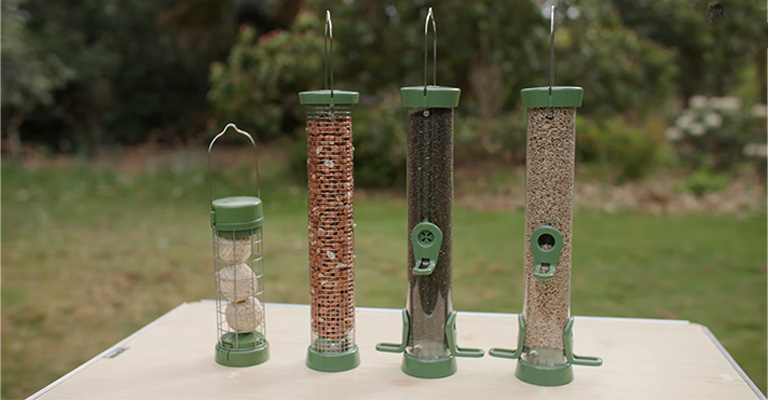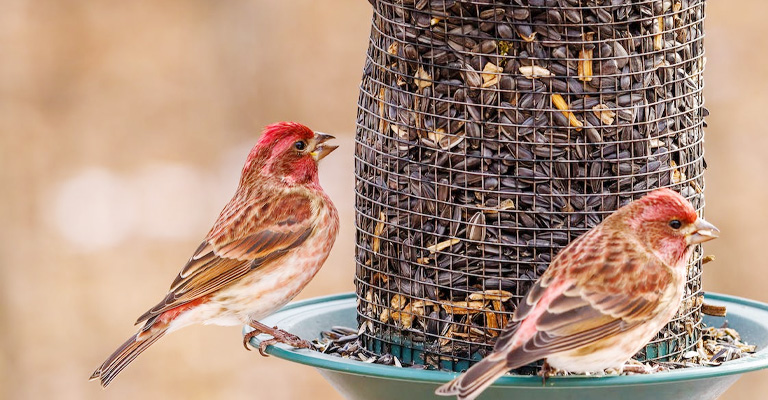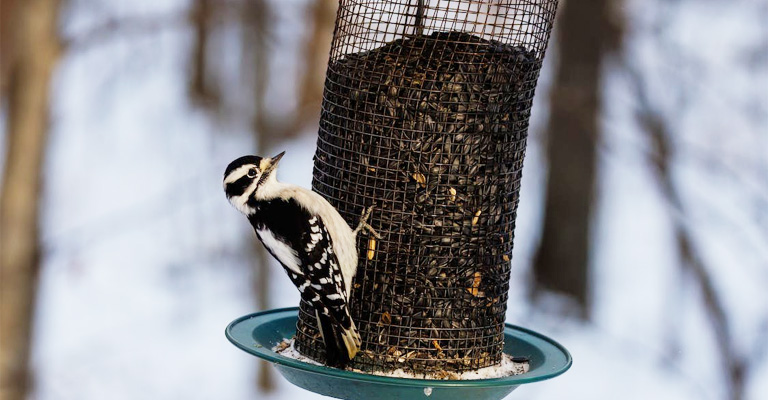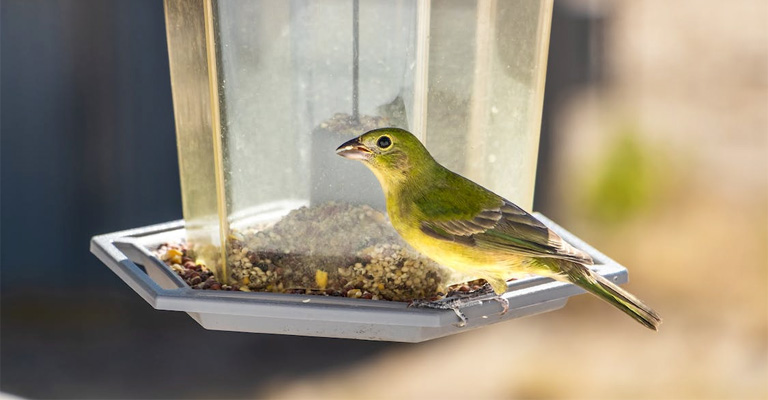The enchanting sight of birds gathering around a feeder can bring joy to any bird enthusiast. However, it’s not uncommon to observe these feathered visitors seemingly squandering the very food they came for.
The question “Why do birds throw seed out of the feeder?” invites us to delve into the intriguing behaviors of avian creatures and uncover the hidden motivations behind their seemingly wasteful actions.
Beyond mere caprice, the reasons behind this behavior reveal insights into bird foraging strategies, survival instincts, and the delicate balance between instinctual behavior and resource optimization.

Why Do Birds Throw Seeds Out Of Feeders?
Birds throw seeds out of feeders for various reasons, and sometimes it can be frustrating or wasteful for the people who feed them.
Here are some common reasons why birds throw seeds out of feeders:
Selective Foraging
Birds are selective feeders, and they have preferences for certain parts of seeds based on nutritional content or ease of consumption.
They might use their beaks to open seeds and then discard the shells, targeting the nutrient-rich kernel.
Shell Removal
Some birds, like finches, have specialized beak shapes that allow them to efficiently remove the outer shell of seeds.
By discarding the hulls, they gain access to the more nutritious inner portion.
Optimal Energy Intake
Birds are instinctively driven to maximize their energy intake from food. By discarding parts of the seed that offer lower nutritional value, they ensure they’re consuming the most energy-dense components.
Seed Size and Hardness
Birds often have a preference for seeds that are a certain size or have a specific level of hardness. They may discard seeds that don’t meet these criteria to conserve energy and time.
Storage and Cache Behavior
Some birds have a natural instinct to store or cache food for later consumption. Discarding seeds could be part of this caching behavior, as they strategically hide seeds for future use.
Preventing Competition
By throwing out unwanted parts of seeds, birds can discourage competition from other birds that might feed on the discarded portions, allowing them to access the more desirable parts themselves.
Removing Inedible Parts

Inedible or unpalatable parts of seeds, such as chemical coatings or toxins, might be discarded to avoid ingestion of harmful substances.
Learning and Behavior Adaptation
Observational learning plays a role. Young birds might learn this behavior from older individuals, gradually refining their technique to maximize food intake.
Seed Manipulation
Some birds manipulate seeds as a way to find hidden insects or larvae. They might throw seeds to uncover hidden food sources within the mix.
In essence, the seemingly wasteful act of birds throwing seeds out of feeders is a demonstration of their resourcefulness and adaptability.
It reflects their finely tuned strategies to obtain the maximum nutritional benefit from their feeding efforts while avoiding less desirable components.
How Can I Attract More Birds To My Feeder?

Attracting more birds to your feeder can be a rewarding and enjoyable hobby. There are many ways to make your feeder more appealing to birds, but the main factors are food, water, shelter, and location.
Here are some tips:
Food
Birds need a reliable and varied food source to survive and thrive. You can offer them different types of seeds, nuts, fruit, nectar, and suet in different types of feeders.
For example, black oil sunflower seeds are popular with many songbirds, while nyjer seeds attract finches and nuthatches. Suet cakes provide fat and energy for woodpeckers and chickadees, while fruit and nectar attract orioles and hummingbirds.
You can also plant native flowers, shrubs, and trees that produce seeds, berries, or nectar for birds to feed on naturally.
Water
Birds need water for drinking and bathing, especially in hot or dry seasons. You can provide them with a birdbath or a shallow dish of water that is clean and fresh.
To make your water source more attractive, you can add a dripper, mister, or bubbler to create motion and sound.
You can also place your water source near some plants or rocks that provide cover and perching spots for birds.
Shelter
Birds need shelter from predators, weather, and competitors. You can create shelter for birds by planting dense bushes, evergreens, or vines that offer hiding places and protection.
You can also provide artificial shelters, such as birdhouses, roosting boxes, or brush piles that offer insulation and security.
You can also avoid using pesticides or chemicals that may harm birds or their prey.
Location
Birds need a safe and convenient location to visit your feeder. You can place your feeder in an area that is visible and accessible to birds but not too close to windows, roads, or other hazards.
You can also place your feeder near a brush pile, hedge, or another type of shelter so birds can feel secure when visiting. You can also hang your feeder from a pole or a branch that is sturdy and stable.
How To Stop Birds From Throwing Seeds On The Ground?

Birds throw seeds out of feeders for various reasons, and sometimes it can be frustrating or wasteful for the people who feed them.
However, there are some methods that you can try to stop or reduce this behavior and save some money and mess.
Here are some effective methods to stop birds from throwing seeds on the ground:
Use A Seed Catcher
A seed catcher is a device that you can attach below your feeder to catch the seeds that fall out. It can be a tray, a net, or a funnel that collects the seeds and prevents them from reaching the ground.
You can buy a seed catcher from a bird supply store or make your own using household materials.
Use A Stable Feeder
A stable feeder is one that does not swing or move too much when birds land on it or eat from it.
A swinging feeder can cause the seeds to spill over and fall to the ground. You can use a feeder that is fixed to a pole or a perch or use a weight or a stabilizer to keep your feeder steady.
Use A No-Waste Seed Mix
A no-waste seed mix is one that contains only seeds that birds like and eat and does not have any fillers or hulls that they discard.
A no-waste seed mix can reduce the number of seeds that birds throw out, as they will not have to sort through the seeds to find their favorites.
You can buy a no-waste seed mix from a bird supply store or make your own by mixing sunflower kernels, peanuts, millet, and other seeds that your birds enjoy.
Use A Tube Feeder
A tube feeder is one that has multiple feeding ports and perches along a cylindrical tube that holds the seeds. A tube feeder can prevent the seeds from falling out, as the birds will have to reach inside the tube to get them.
You can also use a tube feeder with small holes that are suitable for small birds, such as finches or chickadees, and prevent larger birds, such as jays or starlings, from accessing the seeds.
Use A Hopper Feeder
A hopper feeder is one that has a roof and walls that enclose the seeds and protect them from wind and rain. A hopper feeder can also prevent the seeds from falling out, as the birds will have to enter the feeder to get them.
You can also use a hopper feeder with adjustable openings that allow you to control the number of seeds that are dispensed at a time.
Use An Upside-Down Suet Feeder
A suet feeder is one that holds suet cakes, which are blocks of fat mixed with seeds, nuts, fruits, or insects. Suet cakes are high in energy and attract many birds, especially in winter.
An upside-down suet feeder is one that hangs upside down and requires the birds to cling upside down to eat from it.
This can prevent the suet cakes from falling out and also deter unwanted birds, such as starlings or grackles, that cannot feed upside down.
Use Bird-Friendly Plants
Bird-friendly plants are plants that provide natural food sources for birds, such as flowers, berries, nuts, or insects. Bird-friendly plants can attract more birds to your yard and reduce their dependence on your feeders.
They can also provide shelter and nesting sites for birds. Some examples of bird-friendly plants are sunflowers, coneflowers, holly, juniper, elderberry, and viburnum.
Use Bird Deterrents
Bird deterrents are devices or methods that scare away unwanted birds from your feeders or your yard.
Bird deterrents can include visual stimuli, such as scarecrows, shiny objects, fake predators, or motion-activated sprayers; auditory stimuli, such as bells, whistles, alarms, or recordings of bird distress calls.
FAQ
Birds might toss seeds out of the feeder as they search for the most desirable parts. They are looking for seeds with higher nutritional value or easier-to-crack shells, making the most of their foraging efforts.
Although it may seem wasteful, it’s actually a strategic behavior. By discarding certain seeds, birds ensure they consume the most nutritious parts, optimizing their energy intake and survival chances.
Birds often have preferences for specific seeds or parts of seeds. They discard unwanted parts to focus on consuming what provides the most nutritional value, making the most of their feeding time.
Yes, birds with specialized beaks, like finches, are more likely to exhibit this behavior. Their beak shapes allow them to efficiently target certain parts of seeds while discarding the rest.
While it might seem like a waste to us, it’s a natural foraging behavior for birds. Providing a variety of seeds and types of feeders can help accommodate their behaviors and ensure they find suitable food options.
Conclusion
As we unravel the mystery of why birds sometimes toss seeds out of feeders, we gain a deeper appreciation for the intricacies of avian behavior.
While it might appear wasteful at first glance, this behavior often serves as a strategy for birds to locate and access the most nutritious parts of the seed. It’s a testament to their resourcefulness and adaptability in an ever-changing environment.
Ultimately, observing these actions not only enriches our understanding of the avian world but also underscores the importance of providing suitable and varied food sources that accommodate the unique behaviors and preferences of the birds that grace our surroundings.